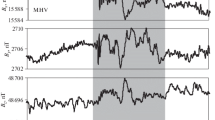Abstract
The global nature of the induced geomagnetic variations was demonstrated using the magnetic observation data obtained at the INTERMAGNET network observatories during the period of the double earthquake on March 16, 2022 (Japan). Their synchronism and comparable amplitude over a wide range of distances from 210 to ~10 000 km, the delay time relative to the considered seismic events (~55 min), and the predominant period of variations of ~30 min are indicative of the fact that the source is a geodynamo perturbed by the action of seismic waves propagating deep into the Earth.
Similar content being viewed by others
Avoid common mistakes on your manuscript.
The Earth’s magnetic field variations are characterized by a wide range of periods and amplitudes [1, 2]. The geomagnetic variation sources include a relatively wide range of geophysical phenomena and processes of the Earth: from turbulent perturbations of material flows in the Earth’s liquid core to the fall of cosmic bodies. Earthquakes are one of the most interesting sources of geomagnetic variations [3–5]. It should be noted that, despite the available data characterizing the disturbances of the Earth’s magnetic field during earthquakes, we have to face a certain lack of observation material needed to specify particular processes and, in a number of cases, the sources of induced geomagnetic variations. In addition, the available information is not complete enough to develop and verify the phenomenological and numerical models to describe the geophysical effects accompanying earthquakes adequately.
In this paper, we consider the magnetic effect of strong earthquakes by the example of a unique event: two underwater earthquakes with a magnitude of 6.0 and 7.3 occurred on March 16, 2022, at close time values (14:34 and 14:36 UTC, respectively) with a distance of ~11 km between their sources (Table 1).
The initial data included instrumental observations of variations in the Earth’s magnetic field induction carried out at a number of INTERMAGNET network observatories (Table 2) [6]. The magnetic observations of the earthquakes of March 16, 2022, were carried out under quiet geomagnetic conditions (Table 3), which greatly facilitated the analysis of the magnetic effect caused by the seismic events under consideration.
According to the data analysis, characteristic variations in the Earth’s magnetic field were recorded in all magnetic observatories in the period close to the time of main shocks. As an example, Fig. 1 shows variations in the horizontal component of magnetic field induction, the most sensitive to external disturbances, in the NS direction minus the B* trend.
In particular, it follows from Fig. 1 that approximately 55 min after the main shocks, the earthquakes caused sign-alternating magnetic field variations with a period of ~30 min almost simultaneously in all observatories at ~15:30 UTC. It should be noted that the amplitude of these variations, according to the data of most observatories, was in a relatively narrow range of 3–8 nT (Table 2).
The observed high synchronism of magnetic disturbances in the period after the mainshocks in a wide range of distances R from 210 to ~10 000 km is indicative of a global disturbing source in this case. Taking into account the delay time comparable with the time a seismic signal travels a distance equal to the Earth’s double size and the period of sign-alternating magnetic field variations reaching approximately half of the delay time, it seems natural to assume that the source of geomagnetic variations in this case is the geodynamo perturbed by seismic waves propagating deep into the Earth.
This assumption is also confirmed by a relatively narrow, as noted above, range of amplitudes of magnetic disturbances caused by the event under consideration at drastically different distances from 210 to ~10 000 km (Table 2).
Indeed, it seems very likely that seismic waves caused by strong, almost simultaneous earthquakes at comparable depths, when propagating deep into the Earth, influence turbulent motions in the Earth’s liquid core and, thus, perturb the geodynamo.
The data obtained make it possible to consider the issue of individualizing earthquakes that have a global effect on variations in the Earth’s magnetic field based on the perturbation process of the magnetic geodynamo by seismic waves.
REFERENCES
V. V. Adushkin, S. A. Ryabova, and A. A. Spivak, Geomagnetic Effects of Natural and Anthropogenic Processes (GEOS, Moscow, 2021) [in Russian].
V. A. Troitskaya and A. V. Gul’el’mi, Usp. Fiz. Nauk 97, 453–494 (1969).
A. A. Spivak and S. A. Ryabova, Izv., Phys. Solid Earth 55 (6), 811–821 (2019).
K. Hattori, Terr. Atmos. Oceanic Sci. 15 (3), 329–360 (2004).
H. Utada, H. Shimizu, T. Ogawa, T. Maeda, T. Furumura, T. Yamamoto, N. Yamazaki, Y. Yoshitake, and S. Nagamachi, Earth Planet. Sci. Lett. 311, 11–27 (2011).
https://www.intermagnet.org/index-eng.php
Funding
This study was carried out under a State Assignment, project no. 122032900185-5, “Manifestation of Natural and Human-Induced Processes in Geophysical Fields.”
Author information
Authors and Affiliations
Corresponding authors
Ethics declarations
The authors declare that they have no conflicts of interest.
Additional information
Translated by E. Maslennikova
Rights and permissions
About this article
Cite this article
Adushkin, V.V., Spivak, A.A. Effect of Strong Earthquakes on the Geodynamo. Dokl. Earth Sc. 511, 563–565 (2023). https://doi.org/10.1134/S1028334X23600494
Received:
Revised:
Accepted:
Published:
Issue Date:
DOI: https://doi.org/10.1134/S1028334X23600494





